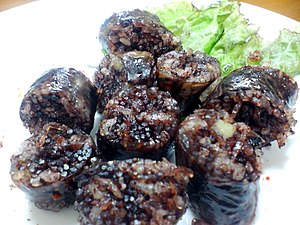Blood sausage
This articleneeds additional citations forverification.(July 2014) |
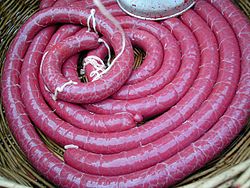 French blood sausage (boudin noir), before cooking | |
| Alternative names | Blood pudding, black pudding |
|---|---|
| Serving temperature | Hot |
| Main ingredients | Blood,grains,meat products,onions,spices |
| Nutritional value per 100 g (3.5 oz) | |
|---|---|
| Energy | 1,586 kJ (379 kcal) |
1 g | |
| Sugars | 1 g |
35 g | |
15 g | |
| Minerals | Quantity %DV† |
| Iron | 36% 6.4 mg |
| Sodium | 30% 680 mg |
This is one of many types of blood sausage, likely with a large amount of addedbacon. | |
| †Percentages estimated usingUS recommendationsfor adults,[1]except for potassium, which is estimated based on expert recommendation fromthe National Academies.[2] | |
Ablood sausageis asausagefilled withbloodthat is cooked or dried and mixed with a filler until it is thick enough to solidify when cooled. Most commonly, the blood of pigs, sheep, lamb, cow, chicken, or goose is used.[3]
InEuropeandthe Americas,typical fillers include meat, fat,suet,bread,cornmeal,onion,chestnuts,barley,oatmeal,andbuckwheat.On theIberian Peninsulaand inLatin AmericaandAsia,fillers are often made withrice.Sweet variants withsugar,honey,orange peel,andspicesare also regional specialties.
In many languages, there is a general term such asblood sausage(American English) that is used for all sausages that are made from blood, whether or not they include non-animal material such as bread, cereal, and nuts. Sausages that include such material are often referred to with more specific terms, such asblack puddingin English.[4]Other varieties of blood sausage includeboudin rouge(Creole and Cajun),rellenaormoronga(Mexico), andsanganel(Friuli).
Africa[edit]
Muturais a traditional blood sausage dish among the people of Mt Kenya region, although recently its popularity has spread throughout Kenya. It is made with meat, blood, and spices all encased in the animal's intestines or stomach.[5]In Kenya fillers include fresh minced goat, beef, mutton, fat, andred onions.
Nowadays many types of mutura, especially commercial street food versions, do not contain blood.[6]The meat used in the filling can be any fleshy part, but like any other type of sausage, prime cuts are not ordinarily used for the stuffing. Instead the tougher, leaner cuts – for example the neck – are trimmed off the bone. The casing for the stuffing is the stomach sac and larger intestines. These are flushed many times with water to clean them.
The meat for the stuffing is finely chopped or minced, and the mandatory fat is often trimmed from other parts. The meat is slightly fried, mixed with finely chopped red onions, salt and optionally fresh chili. Other additions include freshly choppedcoriander(dhania or cilantro), garlic, pepper, and even beef stock. This is then mixed thoroughly with the fresh blood from the animal, and stuffed into the stomach and intestines, with the openings sewn or tied together with string.
The sausage is boiled in a large pot (often with other parts of the animal not roasted and used to make soup) for 30–45 minutes, and roasted over coals till brown. Sliced, it is served withkachumbari,an onion based salad consisting of tomatoes, red onions and fresh coriander, a bit of chili and squeeze of lemon.[7]The accompanying starch isugali.
Americas[edit]
Morcillais served in many areas of Latin America.Morcillais sometimes made with a filler of rice and/or onions, and seasoned withpaprikaand other spices.
North America[edit]
United States[edit]

In theU.S.territoryofPuerto Rico,blood sausage is known asmorcilla.[8]Puerto Rican blood sausage is made with rice,culantro,cilantro,garlic, andCubanellepepper. Some contain paprika andannatto.Morcilla is especially popular during Christmas.
Blood sausages are very difficult to find in USsupermarkets.BrusselsandSturgeon Bay,Wisconsinare both home to local grocers who produce blood sausage, due to their largeBelgian Americanpopulations. Supermarkets throughoutMainealso carry locally produced blood pudding due to the state's largeFrench Canadianpopulation. In southeasternMichigan,Polish-stylekaszankacan be found in supermarkets throughout the year and is very popular.
An Italian-American version of blood sausage in theSan Francisco Bay Areais calledbiroldoand haspine nuts,raisins,spices, and pigsnoutsand is made using either pig's or cow's blood. German-style blood sausage and Zungenwurst can be found inFresnoandSanta Rosa,where Russian and Armenian delis offer a wide range of Central European foods. Alpine Village inTorrance, Californiaused to have Blutwurst due to a considerable German-American population in theSouth Bay areaof Los Angeles County.[9]
Cajunboudinis a fresh sausage made withgreen onions,pork, pork liver (making it somewhat gritty or grainy), and rice. Pig's blood was sometimes added to produceboudin rouge,but this tradition became increasingly rare after the mid-twentieth century due to the decline of theboucherie(traditional communal butchering) and government health regulations prohibiting the transportation of raw blood. As a result, Cajunboudinis now usually made without blood; however, blood or "black"boudincan still be purchased.
Mexico[edit]
In theYucatán Peninsula,morcillais made exclusively from pig's blood and once deep fried it is served with a mix of pickled onions, cilantro and spices. It is always consumed in the form oftacosand paired with freshhabaneropeppers.[10][11]
In Central Mexico,morcillais known asmoronga.[12]
Central America and the Caribbean[edit]
Caribbean[edit]
InAntigua,rice pudding is a local delicacy and it is prepared the same way as blood sausage.
InBarbados,blood sausage, also called pudding, is made with sweet potato (batata), pig's blood and onions, seasoned with peppers and other herbs and stuffed in pig intestines. Traditionally pig's blood was used to darken the mixture but Browning sauce (caramelized sugar) is sometimes used as a substitute. It is normally served withsouse,which is pickled pig's feet, pig's ears and other trimmings. The cooked meat is cut into bite-sized pieces and soaked in a brine made of water, lime juice, cucumbers, hot pepper, and specially prepared seasonings. Blood sausage and souse, more commonly known as pudding and souse, is a Bajan delicacy usually prepared on weekends and special occasions.
In theFrench Antilles,boudin créole,orboudin antillaisis very popular, this being the Frenchboudin noirwith local Caribbean chilli and other spices.[8]
InTrinidad and Tobago,the local style of blood sausage is heavily seasoned with local peppers and traditionally prepared from pig's blood, often replaced by pig's liver today. It is sold by local producers as a popular accompaniment to rolls of crusty hops bread or served as an accompaniment totrotter souse,a stew based on trotters.[13]
In theU.S.territoryofPuerto Rico,it is served fried and mostly consumed during the holidays.
Central America[edit]
InPanama,blood sausage is calledmorcilla,rellenaortubería negra,and is usually filled with rice.
InEl SalvadorandNicaragua,it is called "moronga".
InHondurasandGuatemalaboth "moronga" and "morcilla" are used.
InCosta Rica,blood sausage is calledmorcillaormoronga;but unlike the rest of Latin America, it does not contain rice or other cereals, it is similar to German blood sausage calledBlutwurst.
South America[edit]
Andean[edit]
InEcuador,BoliviaandColombiathe blood sausage is also calledmorcilla,and is usually filled with rice.
InColombia,morcillacan have rice, green peas, cilantro or culantro, and is often eaten as an appetizer called "picada" or with the traditional dishes "Bandeja Paisa" or "Fritanga".InVenezuela,morcillais often served withparrilla(barbecue).
Argentina, Uruguay, Paraguay[edit]

Morcillais also eaten inside a sandwich called "morcipán", especially in theRío de la Plata.Morcillais a component of theasado criollo,a regionalmixed grillorbarbecuemeal. InUruguayand inArgentina,a sweet version, usually calledmorcilla vasca,includingraisinsand pine nuts is popular; some vendors even add chocolate, caramelised orange peels, peanuts, and other dried fruits. Uruguayans usually are fond of sweet or saltymorcilla,and most restaurants and supermarkets carry both versions.
Brazil[edit]
InBrazilthere is a version of the blood sausage calledchouriçoormorcela(sometimes the Castillian Spanish versionmorcillais used as well), consisting of a fresh sausage made of the blood and fat from pork and usuallyrice.It is a variation of the Portuguese blood sausage, and it is known for its deep dark color. In some regions, it is popular on barbecues (Churrascos) as a starter.
Chile[edit]
InChile,the blood sausage is called "prieta" (a synonym of "negra", black) and tends to have a very thick skin, so is eaten cut open lengthwise. Apart from blood and a little fat, "prietas" may contain a variety of ingredients, such as chopped onion and spices, cabbage, peppers, watercress, rice, meat or even dried fruit or nuts. "Prietas" or "morcillas" are part of theChilotetradition of "reitimiento"involving the slaughter and preparation of a pig.
Prietas are easily found at supermarkets throughout the country and are available from practically any butcher.
Guianas[edit]
InGuyana,blood sausage is a very popular snack served at social occasions, and as "cutters" when drinking. The main ingredient is cooked rice seasoned with herbs, such asthymeandbasil.The rice is mixed with cow's blood, stuffed into cow's or pig'sintestine,and boiled until firm, sliced and served with Sour (a mild type of dipping sauce with hot peppers).White puddingis also made.
InSuriname,blood sausage is known by theDutchnamebloedworst,andwhite puddingby the equally Dutch namevleesworst.
Asia[edit]
Across Asia, various people create food from congealed animal blood. Most of these food types do not have casings and might be considered a version ofsliced sausage.
East Asia[edit]
Hong Kong[edit]
In Hong Kong, the dish closest to blood sausage ispig blood curd,which is only made from pig's blood and is not considered a sausage.
Korea[edit]
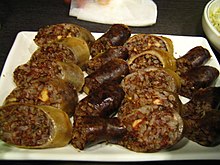
The majority ofKorea'ssundae(순대) can be categorised as blood sausage. The most common type ofsundaeis made of sweet potato noodle (dangmyeon),barley,and pigs blood, but some variants containsesame leaves,green onion,fermentedsoypaste (doenjang), sweet rice,김치,andbean sprouts,in addition to the common ingredients. The Korean sundae is wrapped with pig's intestines. The addition of sweet potato noodle is a more modern addition to the dish. There is another Korean food calledseonjiwhich is cow blood that has been boiled in soup. It looks like the Blodpudding ofSweden.
China[edit]
InChinese cuisines,whole coagulated blood is fried or steamed as asnackor cooked in ahot pot.Inmainland China,"blood tofu"(Chinese:Huyết đậu hủ;pinyin:xuě dòufǔ), or "redtofu"(Chinese:Hồng đậu hủ;pinyin:hóng dòufǔ), is most often made with pig's orduck's blood. Like the above dishes, this has no casing but is simply cut into rectangular pieces and cooked.
In Northeast China, the "blood sausage" was a traditional food which is cooked with sheep or goat blood.
InTibet,congealedyak's blood is a traditional food.[14][15]Chinese people also used pig blood curd that was consumed by laborers inKaifengover 1,000 years ago[16]in the south of China.
InTibetan cuisine,sausages orgyurmarefer to blood sausages and are made with yak or sheep's blood which may or may not include either rice or roasted barley flour as filler. The sausage uses natural casing employing the use of yak or sheep's intestine.[citation needed]
Mongolia[edit]
TheYasapermitted the eating of animal blood and entrails, which was previously forbidden, and blood sausage is now popular inMongolia.
Today, Mongolian blood sausage is sometimes prepared using thekhorkhogmethod.
Japan[edit]
Thekangoterm for blood sausage in Japanese iskecchō(Huyết tràng).After the introduction ofagriculturefrom the Asian continent in ancient times, Japanese culture was traditionallyaverse to blood.As a result, blood-based foods are uncommon in Japanese cuisine.
Before 1945, remote villages inTochigi Prefecture(formerlyShimotsuke Province) were known to producesoresore(それゝゝ),a blood sausage made by filling tied-off sections ofdeerorbearintestine with the animal's blood and boiling them in a metal pot over an open fire until the blood congealed. Once the blood had solidified, the sausage was cut into circular slices and served withsoy sauce.[17]Matagihunters of the formerDewaandMutsu Provincesare known to have made blood sausage using deer intestine andhoshii(Bí しい),or dehydrated boiled rice, as filler. Blood sausage is believed to have been introduced to Japan from theJurchens.
Taiwan[edit]

InTaiwan,"pork blood cake"(Chinese:Trư huyết cao;pinyin:zhū xuě gāo;Zhuyin Fuhao:ㄓㄨˉ ㄒㄧㄝˇ ㄍㄠˉ) or "rice blood cake"(Chinese:Mễ huyết cao;Zhuyin Fuhao:ㄇㄧˇ ㄒㄧㄝˇ ㄍㄠˉ), made of pork blood andsticky rice,is served on a popsicle stick; this is a very popular snack at local night markets.
Southeast Asia[edit]
Indonesia[edit]
InBali,Urutanis a version of blood sausage made with pork intestine and pork blood. It is served with rice.[18]
Another version inJavacalledsarenordideh,is made with chicken's blood and usually cut into small cube pieces.[19]
InSumatra,Kidu-Kiduis aBataksausage dish made from pork intestines, served with sauce made from pork's blood and spices such as andaliman pepper.[20]
Malaysia[edit]
InPenangor other northern states,pig blood curd(known locally inPenang Hokkienas "too huet";Chinese:Trư huyết;pinyin:zhū xuè;lit.'pig's blood') is usually served with the local street delicacyCurry Mee(curry noodles).[citation needed]It can also be mixed with some traditional Hokkien dishes as well.
Philippines[edit]
Blood sausage is known generically aslongganisang dugo(lit. "bloodlonganiza") in thePhilippines.A notable type of native pre-colonial blood sausage ispinuneg,which is composed of minced pork and innards in a pork casing made from large intestines that is prepared in the Cordillera Administrative Region of the Philippines.[21][22]
Thailand[edit]
InThai cuisinesai krok lueat(Thai: ไส้กรอกเลือด) is a blood sausage (Thai:sai krok= sausage,Thai:lueat= blood), often served sliced and accompanied by a spicy dipping sauce. "Blood tofu" is simply calledlueat(Thai:เลือด,blood) inThailand.This can be used in many Thai dishes such as in noodle soups,Thai curries,or as an addition to certain rice dishes such asKhao man kai.
Vietnam[edit]

Vietnamesedồi tiết(Northern) ordồi huyết(Southern) is blood sausage, boiled or fried, made with pork blood, pork fat and basil.
South Asia[edit]
India[edit]
InMeghalayan cuisine,doh snamis type of blood sausage made from pork intestine with local spices and ingredients.[23][24][25][26]
Nepal[edit]
InLimbucuisine,sargembaorsargyangmais a type of blood sausage made mostly from pork intestines, pork fat, rice andyangben,a type of edible wild lichen.[27][28]
Europe[edit]
Central and Eastern Europe[edit]
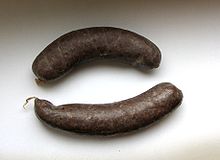

Throughout Central and Eastern Europe, blood sausage, known askishka(meaning "intestine" ), is made with pig's blood and buckwheatkasha.It is also known in Russia askrovyanka(кровянка), orkrovyanaya kolbasa(кровяная колбаса, literally "blood sausage" ), and includesbuckwheatas a main filler, instead of oats or oatmeal. InBelarusit's calledkryvianaja kaŭbasa(крывяная каўбаса) orkryvianka(крывянка). In Ukraine it's calledkrov'yanka(кров'янка) orkryvava kyshka(кривава кишка), andkiszkaorkaszankainPoland;krvavničkainSlovakiaandkrupniokinSilesia.Polishsalceson( "black" and "Brunszwicki") are a type ofhead cheese( "brawn" ) that contains blood. InHungary,véres hurkais typically made with pig's blood and barleycorn or cubed bread (typically zsemle) as filler as such also known aszsemlés hurkaandgerslis hurka.InBulgaria,karvavitsa(кървавица) is usually prepared with pig's blood, fat and a variety of mountain herbs and spices and eaten warm during the winter.
InRomania,the traditionalsângerete(fromsânge,"blood" in Romanian) is made from shoulder butt pork meat, pork blood and a filler such as pre-boiled rice seasoned with pepper, garlic and basil. It has many regional variants, but the most common are thesângeretefromTransylvania.
Similarly, inCzech cuisine,jelitois made from second-rate pork, pig's blood and peeledbarley;the stuffing served by itself, unformed, is calledprejt.
In Polish cuisine it is calledKishkaa/k/aKaszanka.
Northern Europe[edit]
Denmark[edit]
InDenmark,blodpølseis made from pigs's blood and suet, rye flour, brown sugar, raisins, salt, cinnamon and cardamom stuffed into natural or artificial intestines. It is usually boiled in its skin, eaten hot or cold, sometimes sliced and fried, served with syrup, cinnamon and stewed apples.
Estonia[edit]

InEstonia,verivorst(blood sausage) is made of pig's blood, barley groats, pork, marjoram and other flavourings. It is sold and eaten mostly in winter, being a traditional Christmas food. At that time there is a large variety ofverivorstin stores, ranging in shapes and sizes.Verivorstis usually cooked in an oven, but sometimes also fried in a pan.Verivorstis often eaten together withlingonberry jam,but occasionally also with butter orsour cream.Another similar dish is calledverikäkk(black pudding,or blood dumpling, depending on the shape). The popularity ofverikäkkhas decreased during the past decades (possibly because of its less appealing commercial appearance) and has mostly been substituted byverivorst.
Finland[edit]
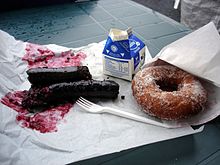
Mustamakkara(literally "black sausage" ) is a roasted sausage containing pig's blood and very similar to Estonianverivorst.The sausage is said to originate fromTampereand is considered an integral part of the city's culture.
A dish similar to the Britishblack puddingis also made by making batter out of pig's blood and baking it like pancakes. Traditionally,ryeflour oroatmealis used and minced onion is added to the mix. This dish is calledveriohukainenorverilettu(blood pancake).Rössypottuis a traditional soup in northern Finland with blood pudding as a main ingredient.
Most blood sausage dishes in Finland are often eaten withlingonberry jamto sweeten the taste.
Iceland[edit]
InIceland,blóðmöris one of two types ofslátur.It is made from lamb's blood and suet, rye flour and oats, traditionally stuffed into pouches sewn from the lamb's stomach. It is usually boiled in its skin, eaten hot or cold, sometimes sliced and fried. After cooking, it is often preserved in fermentedwheyand acquires a distinct sour taste.
Ireland and the United Kingdom[edit]
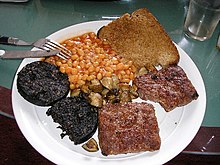
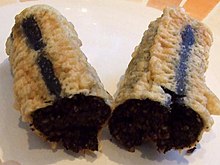
Black puddingis the version of blood sausage native to the British Isles. While the term "blood sausage" in English is understood, it is applied only to foreign usage (e.g., in the storyThe Name-DaybySaki), or to similar blood-based sausages elsewhere in the world. Black pudding is generally made from pork blood and a relatively high proportion of oatmeal. In the past it was occasionally flavoured withpennyroyal,differing from continental European versions in its relatively limited range of ingredients and reliance on oatmeal and barley instead of onions to absorb the blood.[29]It can be eaten cold, as it is cooked in production, grilled, fried or boiled in its skin. It is often served sliced and fried or grilled as part of a traditionalfull breakfast,a tradition that followed British and Irish emigrants around the world. Black pudding is now part of the local cuisine ofNew Zealandand the Canadian provinces ofNova ScotiaandNewfoundland and Labrador.
Stornoway black puddingproduced on theIsle of Lewis,Scotland, is one of the most renowned varieties and has been grantedProtected Geographical Indicator of Origin(PGI) status.[30]Ireland also has two distinctive varieties of black pudding:Sneem Black PuddingfromCounty Kerry,anddrisheen,which is distinguished by its gelatinous texture.
The similarwhite pudding(mealie pudding) is a further important feature of the traditionalNorthumbrian,Scottish,IrishandNewfoundlandbreakfast. Black and white pudding, as well as a third variant,red pudding,is servedbatteredin somechip shopsin England, Scotland and Ireland as an alternative tofish and chips.
Latvia[edit]
InLatvia,blood sausage is either calledasinsdesa(blood sausage) orputraimu desa(groat sausage) because of the addedbarleygroats.It is usually served withlingonberry jamandsour cream.[31]
Sweden[edit]


Blodpuddingis a traditional medieval dish still popular inSweden.The exact proportions and ingredients vary, partly according to regional preference, but generally it is made from pig's blood, milk, rye or barley flour, diced lard, either beer orsvagdricka,treacle and onion, flavoured with allspice and marjoram. It is then poured into forms and oven-baked in a waterbath. Most of theblodpuddingconsumed today is made on industrial basis.
When prepared for serving, it is sliced and fried. The style of serving and accompaniments vary across the country, and it is not uncommon to have theblodpuddingact as the meat in a meal. Nationally, the common way is to serve it with lingonberry jam, grated carrots and ice cold milk to drink. Fried bacon or pork side is also common. InScania,the lingonberry jam is often replaced by finely sliced apples, fried along with the pork.
Other blood-based foods includeblodkorv(blood sausage) which differs fromblodpuddingby having raisins, pork tallow and apple sauce in it,blodplättar(blood pancakes, similar to the original Finnish dishveriohukainenabove) andblodpalt.There is also a soup made from blood, calledsvartsoppa(black soup).
Southern Europe[edit]
Croatia, Bosnia, Serbia, Slovenia[edit]


A similar blood sausage tokarvavitsa,calledkrvavica(крвавица), made out of similar ingredients, is eaten inBosnia,Croatia,Serbia,andSloveniain wintertime, usually withsauerkrautand potatoes.
Italy[edit]
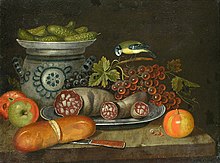
InItaly,regional varieties of blood sausage are known assanguinaccio.InTuscany,buristois a sausage made with pig's blood and fat cooked in a pig's stomach. It is not reheated and is often spread on bread. It is found only in the south of Tuscany in the winter months and even there it can be difficult to come by.Biroldois another type of black pudding which can be found in Tuscany, while the version made in southernLombardyis calledmarsapan.
Migliaccio[32]is a black pudding that is traditionally prepared in winter inRomagna.It is a sweet pudding with a thick black filling made with pig's blood, sugar, breadcrumbs, almonds, chocolate, butter and spices contained in a thin pastry crust. A similar pudding is made throughout southern Italy, generally calledsanguinaccioorsanguinaccio dolce.
Portugal[edit]
InPortuguese cuisine,there are many varieties of blood sausage. Sausages made of blood are usually calledmorcela(for the larger variety) andnegrinha or negrito[33](fromPortuguesenegrothat means dark or black, for the thinner variety). There are many varieties around the Portuguese-speaking world. In Portugal proper, there are local varieties from different regions of mainland Portugal, including fromGuarda,Portalegre,[34]EstremozandBorba,as well as from theAzores.[34]A variety of morcela made withrice,morcela de arroz(rice blood sausage), is typically associated withTomar,[35]Leiria,[36]Porto de Mós,[37]FundãoandBelmonte.[38][39]The morcela is made with a combination of different pork parts, namely blood and pork fat cut into pieces, seasoned with ground pepper, salt, garlic, dried garlic, and spices (includingclovesandcumin), as well as wine in the pig's blood. The morcela is a smoked sausage, is black and has a glossy surface, while its dark interior is marbled with fat. There is also a type of blackchouriço,also a smoked blood sausage because it is made with pig blood together with pig meat. It is calledchouriço de sangue.Places likeMelgaçoand several other localities inNorthern Portugal,as well as inBeirasandAlentejo,are famed for its production.[34][40]
Spain[edit]

Spanishmorcillahas many variants. The most well-known and widespread ismorcilla deBurgoswhich contains mainly pork blood and fat, rice, onions, and salt, and is produced in two varieties: cylindrical and gut-shaped. InAlbaceteandLa Mancha,themorcillais filled with onions instead of rice, which completely changes the texture. InExtremadurathe creamymorcilla patateraincludes roughly mashed potatoes. In the northern regions and theCanary Islandsthere is a sweet variety known asmorcilla dulce.Other varieties introduce breadcrumbs, pine nuts, and almonds, and vary the proportions of the other ingredients or flavourings, some of them considereddelicacies.
There are other similarly famous kinds being made inAsturias(slightly darker and smaller, used for bean and chickpea stews) andLeón(without rice, grilled & spread on toasted bread). Other less popular varieties may addcuminto the pudding mixture, but this is not a standard practice. The cooking method for consumption is typically frying, stewing, grilling or roasting, often in served in slices and either as a side dish or on its own. There are many derivative foods made from morcilla, such asomelettes,stuffed red pepper,puff pastry,pizza, flavourednachos,croquettes,and a range of fillings for different dishes.
In Galicia, blood pancakes are called filloas.[citation needed]
Malta[edit]
The Maltese blood sausage is known asmazzita(plural:mazzit). It was first described in the 1750s inGiovanni Pietro Francesco Agius De Soldanis’sDamma tal-Kliem Kartaginis mscerred fel fomm tal Maltin u Ghaucin,listing words of Carthagenese oriġin spoken widely acrossMaltaandGozo.[41]The production of blood sausages in Malta was temporarily halted in 2004 whenMalta joined the European Union,as no adequate machinery was available in the country to ensure that the blood was handled according to EU standards. However, it was reintroduced on the local market in 2024, when appropriate equipment was procured by the state-run slaughterhouse to gather the blood in appropriate sanitary conditions.[41]
Western Europe[edit]
Belgium, Netherlands and Luxembourg[edit]
InBelgiumandthe Netherlands,exist 2 varieties one calledbloedworstand the other is calledbeuling.
Bloedworstis a big sausage 4-inch-diameter (100 mm) with white chunks of suet, which is sold in slices of roughly 0.5-inch (13 mm).[42]It is generally pan fried; sometimes apples are cooked alongside or on top of the pieces. It is also eaten with apple sauce, brown sugar, syrup or red cabbage. As acold cut,thin slices are eaten as a sandwich topping.
Beulingalso calledZwarte pens(as opposed to the white variety that is referred to asWitte pens) are individual blood sausages the size of a banana, the filling of which is uniform.[42]
Both are made of blood, from predominantly cows or pigs, sometimes sheep or horse blood are used in specialty products. The blood is mixed with breadcrum, wheat- or potatoflour, or any combination thereof, and fatty parts of the head, belly and organ meat such as lung, tongue, heartmuscle, and spleen.[43]
TheLuxembourgträipenincludes green cabbage, and is served pan fried with apple sauce. It was eaten in church in the Middle Ages duringCarnivaland is still consumed for breakfast, baked with apples and topped with apple syrup, during Carnival in the Dutch province ofLimburg.[citation needed]
France and southern Belgium[edit]
InFranceand Wallonia (south Belgium)boudin noiris traditionally prepared incharcuteries,shops that prepare mainly pork products (and sometimes duck and game), but also sell smoked and driedsausages,pâtés,andterrines,along with prepared salads. It is usually calledboudin noirand is often made with cream with apples or onions as a filler. It is generally served with either cooked apples, mashed potatoes or both, and is appreciated by combining either the apples or mashed potatoes with each bite ofboudin,which has been gently heated and browned in butter. In France also, there are many different regionalBoudins Noirssuch as the largeBoudin du Béarnwith pork meat pieces usually eaten cold. The FrenchConfrérie des Chevaliers du Goûte-Boudin(Brotherhood of the Knights of Blood Sausage Tasting) inMortagne-au-Perchein southernNormandyholds an annual contest of international blood sausage specialities. Boudin is considered the emblematic staple of theFrench Foreign Legion,and gives its name to the Legion'santhem.
Germany and Austria[edit]


The most common variant ofGermanBlutwurstis made from pork rind, pork blood and regionally different fillers such asbarley.Though already cooked and "ready to eat" it is sometimes served warm, similar to the style in France. In theRhineland,where it is also traditionally made fromhorse meat,friedBlutwurstis a constituent of various dishes. In particular inCologne,the traditionalHimmel und Erde(Heaven and Earth) combinesapple sauce,mashed potatoes andBlutwurstserved hot on one plate. InBerlin,hotBlutwurstmixed together withliverwurstand potatoes is called "Tote Oma"(" Dead Grandma ").
Other German variants areZungenwurst,which isBlutwurstmixed with pieces of pickled ox tongue, andBeutelwurst,which is pressed in a linen or paper bag (Beutel). A variety ofBlutwurst,theRotwurstfromThuringia(Thüringer Rotwurst), hasgeographical indicationprotection under EU law, withPGIstatus.Kartoffelwurst(potato sausage) is a post-World War IIvariety popular in thePalatinate,a reduced fat version ofBlutwurstusing potato cubes instead of bacon.
InAustriait is often prepared in a dish known asBlunzngröstl,which consists of pan-fried potatoes and blood sausage. This is usually served with freshly gratedhorseradish.
Symbol of Carnival[edit]
Many Roman Catholics celebrateMardi Gras,the last day of carnival, (Literally meaningCarne Vale,farewell to Meat in Italian) with rituals involving the blood sausage. For example, in Spain, they celebrate carnival withjudías con morcilla(morcilla is a variation of Blood sausage) followed by thefuneral of the sardina.[44][45]
Likewise, in Belgium and the Netherlands, the Bloodsausage is a symbol for Carnival (most likely following the invasion of Spain during theEighty Years' War).[46]
François RabelaisinFrancementions in his "fourth book" (1552) carnavalesque figures calledforest-dwelling Blood-puddings(Saulcis- sons montigènes, Boudins sylvatiques) as a farce representing the Swiss and German Protestants.[47]
Additional varieties[edit]
Other varieties of blood sausage includeblodpølse(NorwayandDenmark),tongenworst(with added pigs tongues) (Netherlands),krvavica(Balkans),krovianka(Belarus,Russia andUkraine), andvėdarai(Lithuania).
Gallery[edit]
-
Blood sausage (black sausage)Iberian Peninsulastyle
-
Blood sausageKorean Peninsulastyle
See also[edit]
References[edit]
- ^United States Food and Drug Administration(2024)."Daily Value on the Nutrition and Supplement Facts Labels".FDA.Archivedfrom the original on 27 March 2024.Retrieved28 March2024.
- ^National Academies of Sciences, Engineering, and Medicine; Health and Medicine Division; Food and Nutrition Board; Committee to Review the Dietary Reference Intakes for Sodium and Potassium (2019). Oria, Maria; Harrison, Meghan; Stallings, Virginia A. (eds.).Dietary Reference Intakes for Sodium and Potassium.The National Academies Collection: Reports funded by National Institutes of Health. Washington, DC: National Academies Press (US).ISBN978-0-309-48834-1.PMID30844154.Archivedfrom the original on 9 May 2024.Retrieved21 June2024.
- ^"Blood sausages".meatsandsausages.com.Retrieved22 December2020.
- ^"A Guide To Traditional Black Pudding".English Breakfast Society.Retrieved4 November2019.
- ^Mutura – The traditional Kenyan sausageby Village Talk accessed on 1 May 2014
- ^Canduh."Street Food: Mutura".Foodies Kenya.Retrieved22 December2020.
- ^"In Kenya, Making This Sausage Is Its Own Festive Occasion".Atlas Obscura.Retrieved22 December2020.
- ^ab"Black Pudding: A The Blood and Guts Taste of the Caribbean".uncommoncaribbean.com.Retrieved22 December2020.
- ^Pérez, Gillian Morán (4 March 2023)."Auf Wiedersehen To Alpine Village As Shop Owners Pack Up On Word Longtime German American Hub Is Closing".LAist.Retrieved4 March2023.
- ^Ethnic Food Lover's Companion: A Sourcebook for Understanding the Cuisines of the World[1]
- ^Yucatán: Recipes from a Culinary Expedition, By David Sterling
- ^"Moronga".meatsandsausages.com.Retrieved22 December2020.
- ^Dave DeWitt & Mary Jane Wilson: Callaloo, Calypso & Carnival, p.62. The Crossing Press 1993
- ^Ma Jian,Stick Out Your TongueChatto and Windus London, 2006.
- ^Uses of yak blood in TibetArchived1 April 2009 at theWayback Machine.Retrieved on 9 May 2009.
- ^Nina Edwards Offal: A Global History Reaktion Books, 2013 p.30-32
- ^栃 mộc の thực sự biên tập ủy viên hội Tochigi no shokuji henshū iinkai (1988).Văn き thư 栃 mộc の thực sự toàn tập Kikigaki Tochigi no shokuji zenshū.Japan: Nông sơn ngư thôn văn hóa hiệp hội Nōsan Gyoson Bunka Kyōkai.ISBN4540880322.
- ^"13 Bizarre Foods and Drinks in Bali".hotels.com.Retrieved14 November2021.
- ^"Saren, Makanan Berbahan Dasar Darah Asal Indonesia".indozone.id(in Indonesian). 21 September 2020.
- ^"Cipera: Masakan Karo yang Mirip Colombia".detikfood(in Indonesian). 30 September 2010.Retrieved22 September2021.
- ^"Longganisa Dugo (Blood Sausage)".Panlasang Pinoy Meaty Recipes.12 February 2018.Retrieved25 March2019.
- ^"Baguio eats: Head to this restaurant for a literal taste of blood".ABS-CBN News.30 October 2018.Retrieved25 March2019.
- ^"101 India | the Shillong food trail with Khasi Bloodz".
- ^"Blood rice to blood sausages: Here's a look at Shillong's crazy food".
- ^"The Shillong Food Trail with Khasi Bloodz".2 January 2017.
- ^"Also sell the food, dude!".
- ^Noyoz,The Nepali Times,18-24 Jan 2013
- ^Subba, J. (2008)History, Culture and Customs of Sikkim,Gyan, p.133
- ^Jaine, T. and Davidson, A.The Oxford companion to food,OUP, 2006, p.104
- ^"Stornoway black pudding given protected status".BBC News.8 May 2013.Retrieved15 October2014.
- ^"Latgalian recipes: Blood Sausage".Public Broadcasting of Latvia.14 August 2019.Retrieved12 August2019.
- ^"La scienza in cucina e l'Arte di mangiar bene"by Pellegrino Artusi; recipe n. 702
- ^"Negrito, Enchidos de Lavos, Figueira da Foz".enchidosdelavos.com(in Portuguese).Retrieved16 March2023.
- ^abcFernandes, Daniel."Produtos Tradicionais Portugueses".Produtos Tradicionais Portugueses(in Portuguese).Retrieved16 March2023.
- ^"Rice blood sausage (" Morcela de arroz ") – Foto de Cervejaria do Fernando, Tomar - Tripadvisor".www.tripadvisor.pt(in European Portuguese).Retrieved16 March2023.
- ^"VivaLeiria | Morcela de Arroz".www.vivaleiria.pt(in Portuguese).Retrieved16 March2023.
- ^"Morcela com arroz e receita secreta é o petisco mais procurado em Porto de Mós".TVI Notícias(in Portuguese).Retrieved16 March2023.
- ^Quitério, José (4 October 2014)."Ataíja de Cima: Morcelas de Arroz".Ataíja de Cima.Retrieved16 March2023.
- ^"Feira da Morcela e do Arroz Doce | Olas".Turismo Centro Portugal(in Portuguese).Retrieved16 March2023.
- ^"CHOURIÇO DE SANGUE: O QUE É E COMO FAZER".alheiras.com.8 August 2020.
- ^abEllul, Daniel (27 March 2024)."Blood sausage is back on the menu".Times of Malta.Retrieved27 March2024.
- ^ab"Zwarte pens vs. Bloedworst".Radio 2(in Dutch).Retrieved19 October2020.
- ^{{cite web|access-date=2024-06-07|title= "Worstlog" |url=https://www.worstlog.com/2007/11/12/bloedworst-maken/%7Clanguage=nl
- ^"Most well-known carnivals in Costa Brava region".23 March 2016.
- ^Guitar, Lynne. "The Origins of Carnival--": 20.
{{cite journal}}:Cite journal requires|journal=(help) - ^De Aarde en haar volken – Google Books.A. C. Krusemen. 1870.Retrieved21 December2019.
- ^"Rabelais's Carnival".Retrieved21 December2019.
External links[edit]
- The Black Pudding.A history and guide by The English Breakfast Society.
- Black pudding recipefrom uktv food
- Blood sausages
- English cuisine
- Estonian cuisine
- Scottish cuisine
- Northern Irish cuisine
- Irish cuisine
- Italian cuisine
- Argentine cuisine
- Chilean cuisine
- German cuisine
- Ukrainian cuisine
- Mexican cuisine
- Filipino cuisine
- Puerto Rican cuisine
- Russian cuisine
- Uruguayan cuisine
- Venezuelan cuisine
- Vietnamese cuisine
- Taiwanese cuisine
- Lancashire cuisine
- Meat and grain sausages


